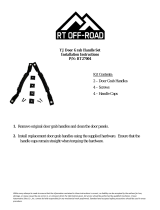
2
FUNCTIONAL TRAINING ARMS
BODYCRAFT was the first company to incorporate Functional Training
Arms into the standard multi-function home gym. This extremely versatile
station opened up a vast array of exercises and we cannot imagine making a
home strength training system without it. Your Functional Training Arms
provide exercises that pertain to everyday living. You can train specifically
for your favorite sport or activity, or for tasks required to help make it
through your day. We encourage you to be inventive with your Functional
Training Arms. You can easily invent motions unique to you. Just be care-
ful to always be in control and work to balance your body.
GENERAL EXERCISE GUIDELINES
There are many theories as to the proper number of repetitions and sets
ofrepetitionsrecommendedforanyspecificexercise.Infact,weareall
unique individuals and what may be effective for one person may not be as
effective for another. Your genetic makeup, goals, and available time are all
specifictoyou.Inadditiontoreadingthisbook,werecommendconsulta-
tions with
fitness professionals such as a certified personal trainer and your local spe-
cialty fitness dealer.
Thehumanbodyisahighlyadaptivemachine.Itcanquicklyadjustto
routine stresses. Therefore, intensity and variety are vital components of
anystrengthtrainingroutine.Intensityismoreimportantthanaspecific
number of repetitions or sets of repetitions. The amount a muscle group
is stressed (to failure) is directly proportional to the amount of increased
strength/growth.Inotherwords,themoreeffortyouputintotraining,
the more results you should receive! Periodically changing the routine is
also highly recommended. Your body will become accustomed to a rou-
tine. Variety will increase your results!
Please remember to start easy and increase the total time and number of
repetitions gradually. Overdoing it in the beginning can cause unnecessary
musclesoreness.Ifatanytimeyoufeelexcessiveorunnaturalpain,stop
immediately! Determine what is wrong before continuing. See your
physician if you have any doubts.
Ingeneralterms,formaximummusclebuilding,werecommend6-12
repetitions and 2-3 sets per exercise. For endurance training, We recom-
mend12-20repetitionsand2-3setsperexercise.




















